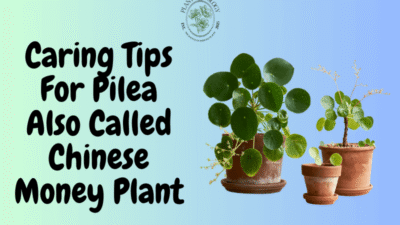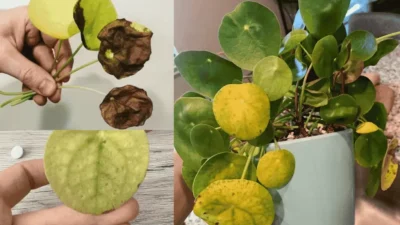The fiddle leaf fig (Ficus lyrata), with its large, sculptural violin-shaped leaves, has become a cornerstone of modern interior design.
While its reputation for being temperamental often precedes it, this striking plant will thrive with a consistent and informed care routine.
Understanding its origins in the lowland tropical rainforests of Western Africa is the first step to success, as the goal of fiddle leaf fig care is to replicate those warm, humid, and bright conditions within the home.
This guide provides a detailed roadmap for both novice and experienced plant owners, covering everything from daily maintenance to troubleshooting common problems.
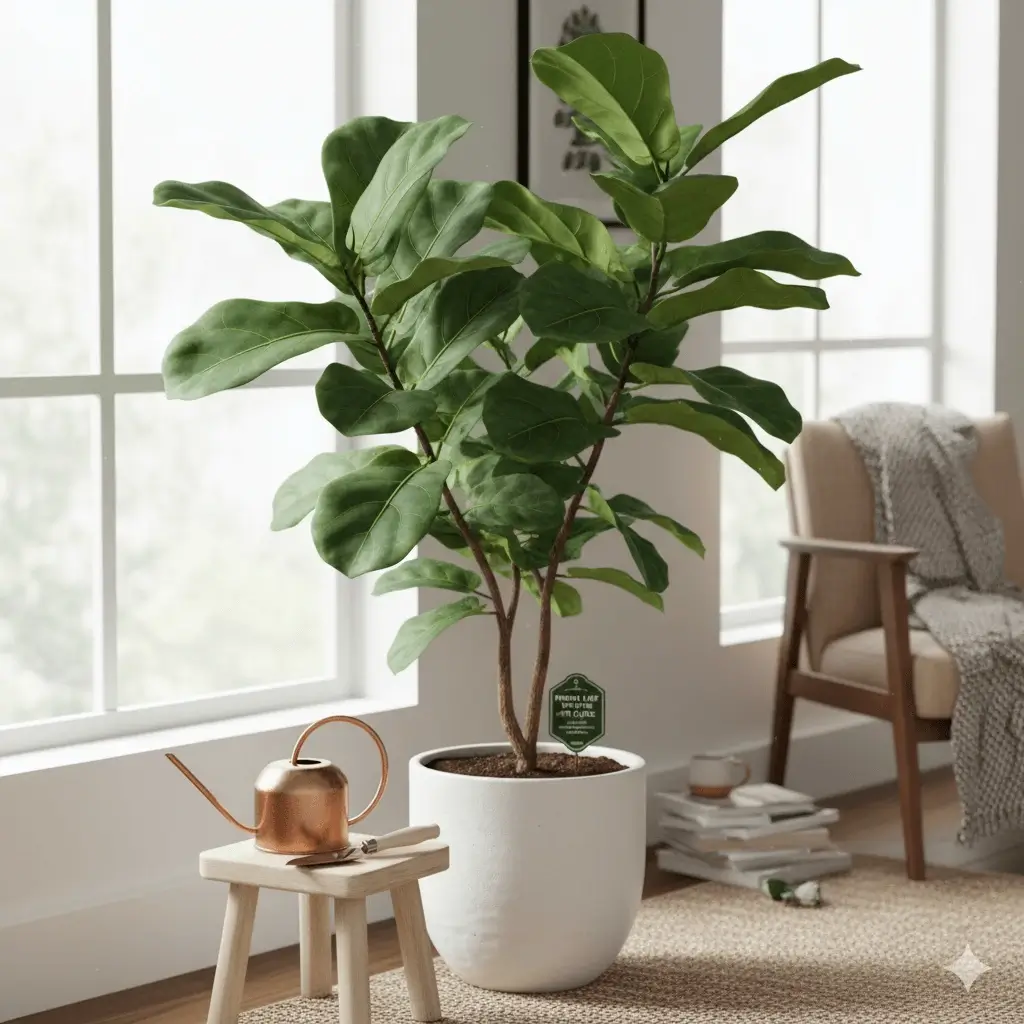
Table of Contents
Fiddle Leaf Fig Care Indoors: Creating an Ideal Home Environment
Caring for a fiddle leaf fig indoors involves balancing several key factors: light, water, and soil. The right combination encourages vigorous growth and prevents the most common issues.
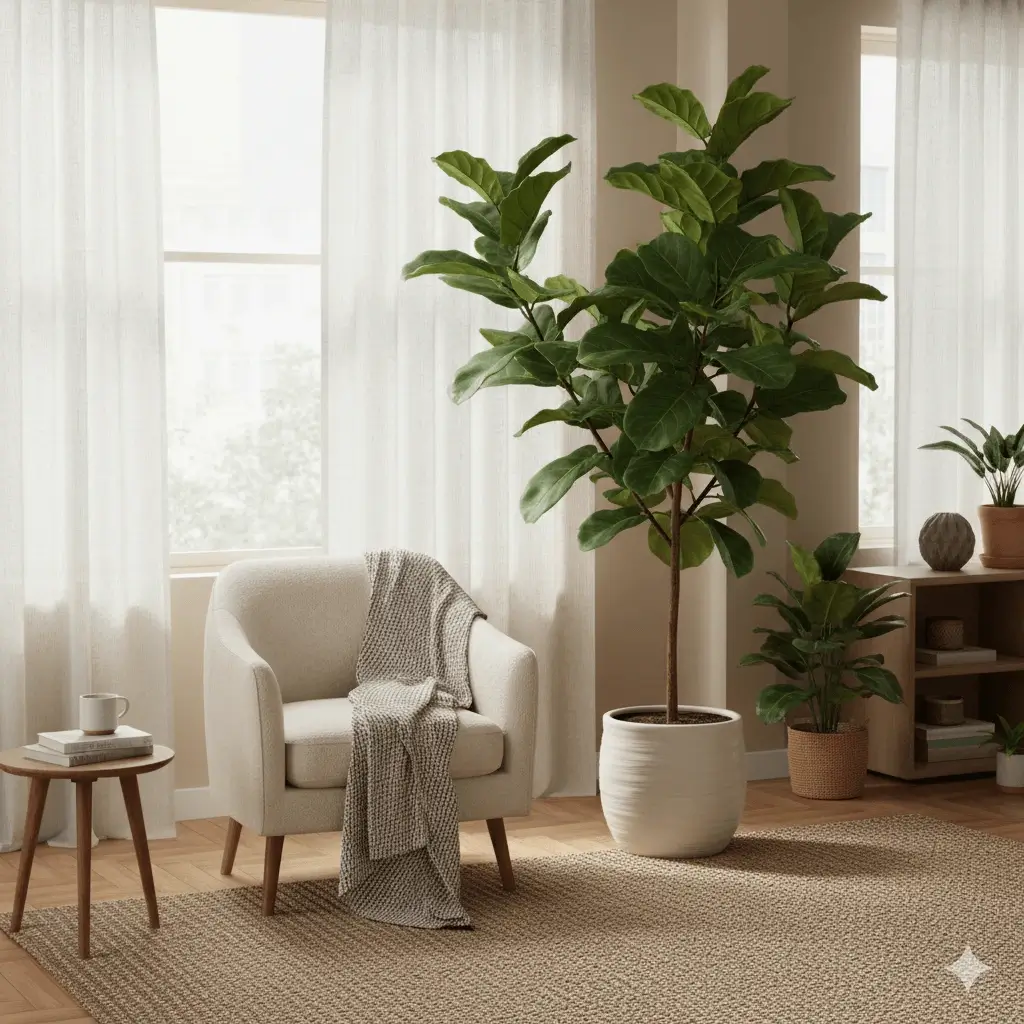
- Light Requirements: These plants crave bright, indirect light. An east-facing window is often ideal, providing plenty of morning sun without the harsh intensity of the afternoon. A south or west-facing window can also work if the plant is placed a few feet back or shielded by a sheer curtain to prevent leaf scorch. Insufficient light will result in slow growth, small new leaves, and leaf drop.
- Watering Technique: Proper watering is arguably the most critical aspect of fiddle leaf fig care. The goal is to mimic the conditions of a forest floor: moist beneath the surface but not soggy. Water deeply only when the top 2–3 inches of soil have dried out. When watering, do so thoroughly until water runs freely from the drainage holes, and always empty the saucer afterward to prevent root rot. Using a moisture meter can eliminate the guesswork and help establish a reliable routine.
- Soil and Potting: A well-draining, peat-based potting mix is essential. Many growers recommend a blend of two-thirds peat moss and one-third perlite for optimal drainage and aeration. The choice of pot is equally important; it must have drainage holes and should only be 2–3 inches wider in diameter than the plant’s root ball when repotting. A pot that is too large will hold excess water, increasing the risk of root rot.
Fiddle Leaf Fig Care Outdoors: Transitioning to the Great Outdoors
In USDA Hardiness Zones 9–11, fiddle leaf figs can thrive outdoors year-round. For those in cooler climates, moving a potted plant outside for the summer can give it a significant boost in growth.
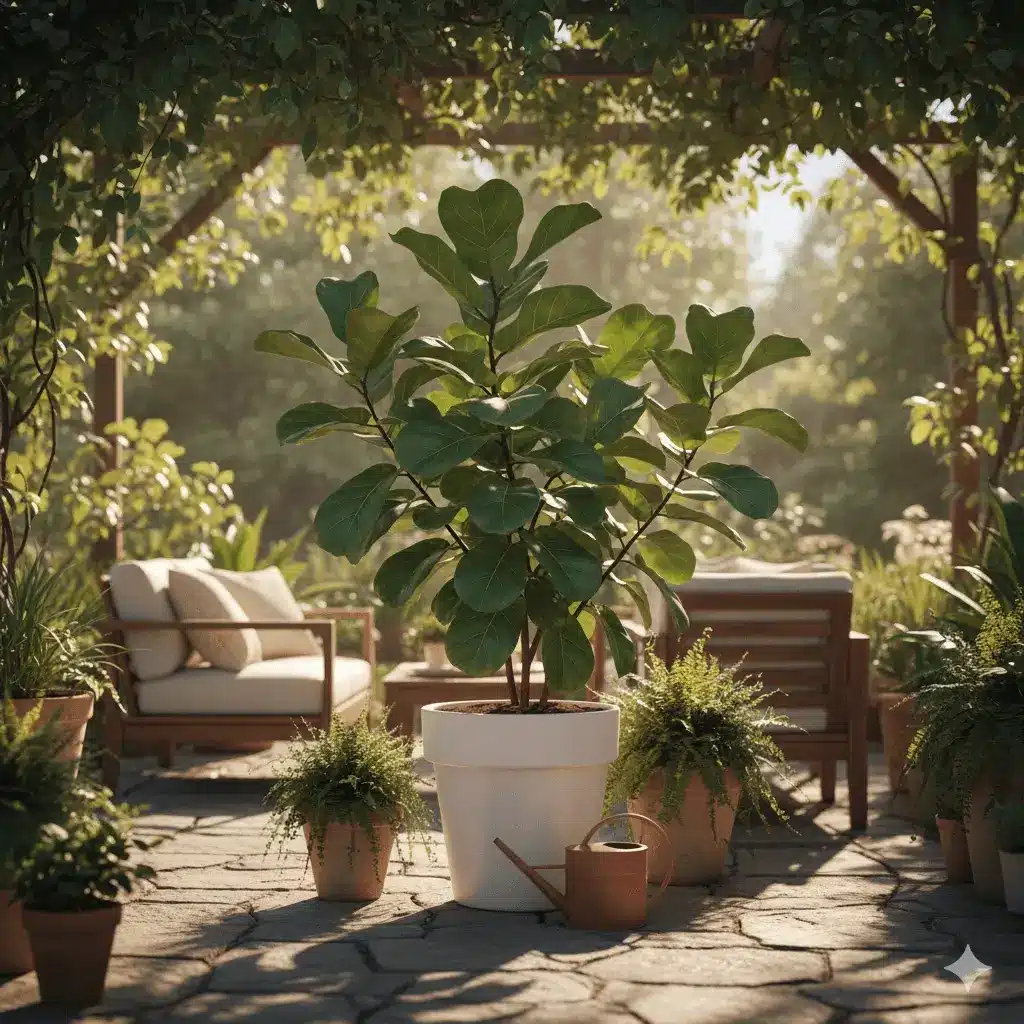
- Acclimation is Critical: Never move a fiddle leaf fig directly from indoors to full sun. The intense UV rays will scorch the leaves. Start by placing the plant in full shade for a week or two, then gradually introduce it to brighter light over several weeks.
- Ideal Outdoor Conditions: Once acclimated, the plant should be placed where it receives dappled sunlight or bright, indirect light, similar to its native under-canopy habitat. A spot on a patio under an awning or beneath a pergola works well.
- Weather Considerations: Outdoor plants may require more frequent watering, especially during hot, dry periods, as they will dry out faster than indoors. Always bring the plant back inside if temperatures are forecast to drop below 50°F (10°C).
- You May Also Like: Geogenanthus Ciliatus Care: Indoor and Outdoor Growing Tips
Fiddle Leaf Fig Care for Beginners: Essential Tips for Success
For those new to fiddle leaf figs, focusing on consistency and observation is key. Avoiding common mistakes will set your plant up for long-term health.
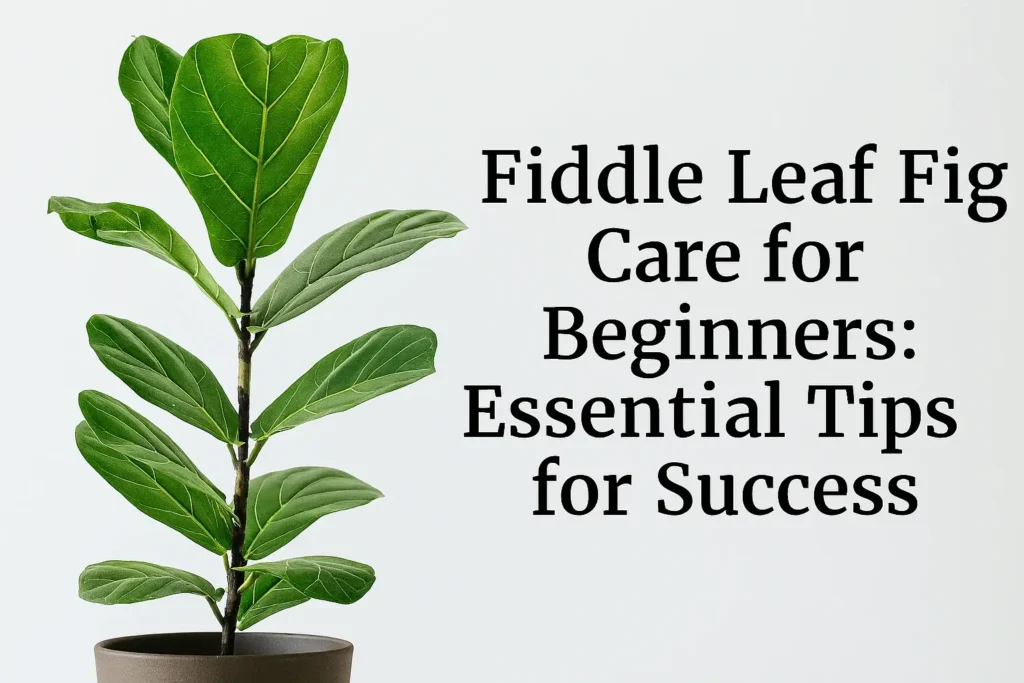
- Avoid Over-care: Beginners often love their plants too much with excessive water, fertilizer, or frequent moving. Fiddle leaf figs prefer stability. Find a good spot with appropriate light and stick to it, only moving the plant if it shows clear signs of distress.
- Establish a Check-up Routine: Instead of watering on a strict schedule, make it a habit to check the soil moisture weekly. Regularly wipe the large leaves with a damp cloth to remove dust, which allows the plant to photosynthesize more efficiently and also gives you a chance to inspect for pests.
- Understand Plant Communication: Learning what your fiddle leaf fig is telling you is crucial. Drooping leaves often signal thirst, while brown spots can indicate issues ranging from overwatering to disease. Correctly responding to these signs is the foundation of successful fiddle leaf fig care.
Fiddle Leaf Fig Brown Leaves: Diagnosing the Cause
The appearance of brown leaves is a common concern, but the location and pattern of the browning provide vital clues to the underlying problem.
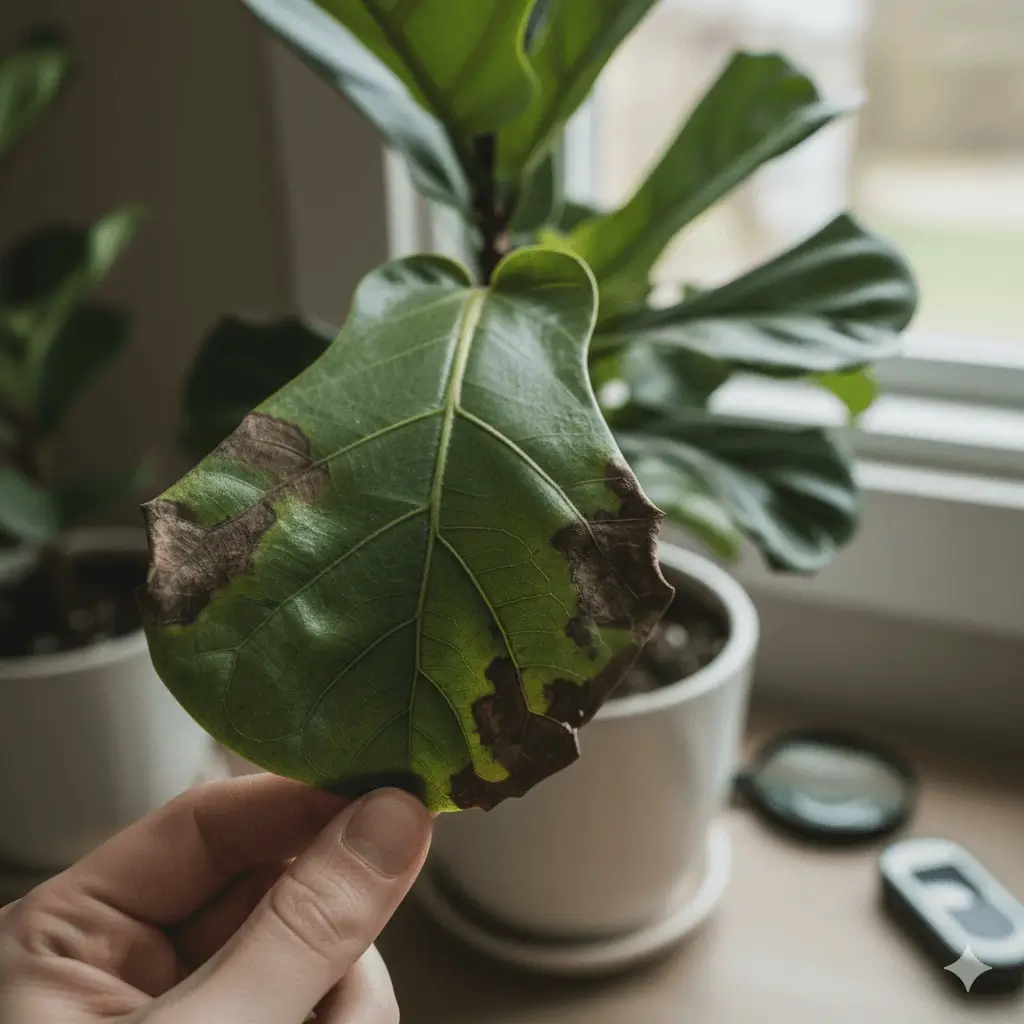
| Symptom | Likely Cause | Solution |
|---|---|---|
| Brown spots starting at the leaf center, spreading outward; leaf drop | Overwatering / Root Rot | Check soil moisture; repot if roots are mushy; use well-draining soil. |
| Browning starting at the edges, moving inward; crispy texture | Underwatering / Low Humidity | Water deeply when topsoil is dry; increase humidity with a pebble tray or humidifier. |
| Light brown, scorched-looking spots on top leaves, often after moving | Sunburn | Move plant to a location with bright, indirect light; acclimate slowly to new light conditions. |
| Brown spots with a yellow halo; spots may appear anywhere on the leaf | Bacterial Infection | Improve air circulation; remove affected leaves; avoid getting leaves wet when watering. |
Fiddle Leaf Fig Care in Pots: Mastering Container Gardening
Container gardening presents specific challenges, primarily related to moisture management and root health.
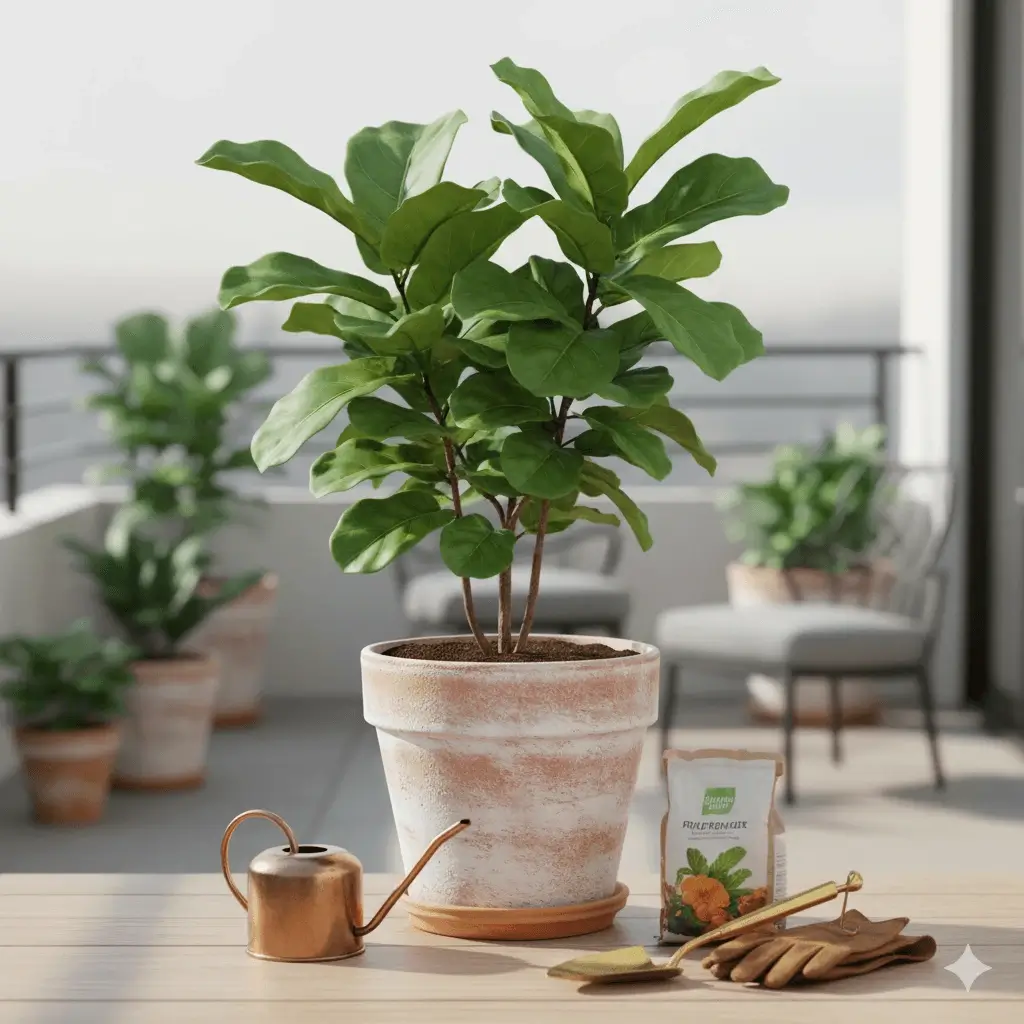
- Repotting Schedule: A young, actively growing fiddle leaf fig may need repotting every 1–2 years. The best time to repot is in spring or early summer. Signs that it’s time include roots growing out of the drainage holes, water sitting on the soil surface without absorbing, and slowed growth.
- The Repotting Process: When repotting, choose a container only 2–3 inches larger in diameter. Gently loosen the root ball and place the plant in the new pot with fresh, well-draining soil. Ensure the root crown sits slightly above the soil line to prevent rot. Do not add gravel or rocks to the bottom of the pot, as this raises the water table and worsens drainage.
- Fertilizing: During the growing season (spring and summer), feed your fiddle leaf fig with a balanced, high-nitrogen fertilizer. An NPK ratio of 3:1:2 is ideal for lush foliage. Fertilize monthly according to the product instructions and stop feeding during fall and winter when growth naturally slows.
People Also Ask: Fiddle Leaf Fig Care Questions
- How often should I water my fiddle leaf fig?
There is no universal schedule. Watering frequency depends on light, temperature, and pot size. Always check the soil and water only when the top 2–3 inches are dry. - What type of fertilizer is best for a fiddle leaf fig?
A high-nitrogen fertilizer with an NPK ratio of 3:1:2 is best for promoting leafy growth. Use a liquid fertilizer during the growing season. - Can a fiddle leaf fig tolerate low light conditions?
No. While it can survive for a while in medium light, it will not thrive. Insufficient light leads to leggy growth, small leaves, and increased susceptibility to overwatering issues. - Why are the leaves on my fiddle leaf fig turning yellow?
Yellow leaves can be a sign of overwatering, poor drainage, or sometimes a nutrient deficiency. Check your watering habits and soil condition first. - Is it normal for a fiddle leaf fig to drop its leaves?
Some leaf drop, especially of lower leaves, is natural as the plant grows. However, sudden or significant leaf drop is usually a stress response due to overwatering, underwatering, or a drastic change in environment. - How can I increase humidity for my fiddle leaf fig?
Group plants together, use a room humidifier, place the pot on a pebble tray filled with water, or mist the leaves occasionally. - How do I clean my fiddle leaf fig’s leaves?
Gently wipe both the top and bottom of each leaf with a soft, damp cloth. This removes dust and helps the plant breathe and absorb light. - Should I mist my fiddle leaf fig?
Misting can help increase humidity, but it is not a substitute for proper watering at the roots. Avoid over-misting, as water sitting on leaves can promote fungal issues. - When should I repot my fiddle leaf fig?
Repot in spring or early summer when you see roots circling the pot or growing out of the drainage holes, or when the plant dries out unusually quickly. - How can I make my fiddle leaf fig bushier?
Pruning the top of the main stem will encourage the plant to branch out and become bushier rather than growing tall and leggy. - Are fiddle leaf figs toxic to pets?
Yes, like other Ficus plants, fiddle leaf figs are considered toxic to cats and dogs if ingested. They can cause oral and gastrointestinal irritation. - What is the white stuff on my fiddle leaf fig’s leaves?
This could be mineral deposits from hard water or a sign of powdery mildew. Wipe the leaves with a damp cloth. If it looks powdery and doesn’t wipe off easily, it may be mildew, which requires treatment with a fungicide. - Can a sunburned leaf recover?
No, the damaged tissue will not turn green again. You can leave the leaf if the damage is minor, or prune it off for aesthetics. The key is to move the plant to a more suitable location to prevent further damage. - What are the tiny bugs on my plant?
Common pests include spider mites, mealybugs, and aphids. Isolate the plant and treat it with insecticidal soap or neem oil, ensuring you cover the undersides of the leaves. - How fast does a fiddle leaf fig grow?
With ideal care, a fiddle leaf fig can grow 1 to 2 feet per year. Growth will be slower in lower light conditions or if the plant is root-bound.
Other Plant Factology Blogs: Show More


